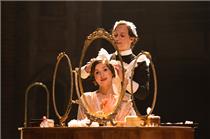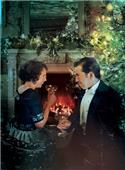Love’s Labour’s Lost/ Love’s Labour’s Won
RSC/ Stratford on Avon
 Richard Lutz takes in a twinning of two Shakespeare plays – one lyrical and the other a well-known classic.
Richard Lutz takes in a twinning of two Shakespeare plays – one lyrical and the other a well-known classic.
The Royal Shakespeare Company has an idea that these two plays, Love’s Labour’s Lost and Love’s Labour’s Won (aka Much Ado About Nothing) are a pair, two sides of a coin, consequent plays written by Shakespeare within four years of each other.
But no one really knows just what the latter, Love’s Labour’s Won, really is. Is it a missing play (mentioned in contemporary diaries) or is it another name for Taming of the Shrew or even the much-loved Much Ado About Nothing? No one knows.
Director Christopher Luscombe assumes the latter, placing the first at the beginning of the First World War and the latter, Much Ado…, at the end.
Both are set solidly in the same location, a grand evocation of nearby Charlecote House, and uses the same actors which makes for easy linking of the two.
But they are such different plays. Love’s Labour’s Lost is almost operatic with Shakespeare at his most lyrical, his most witty and his most verbal. It could be a radio play with its major emphasis on startling wordplay. An expert wrote that to enjoy it today, just let the language swim past and take in the eloquence and the verbal fun. Don’t worry too much about the plot which is simple: four courtiers take to a retreat for three years to study. But along come four ladies and…wham, there goes good intentions.
 On the other hand, Love Labour’s Won (aka Much Ado…) is plot driven and sparkling with the barbed 20th century sparring between Benedick and Beatrice. Think Spencer Tracey and Katherine Hepburn on the stage.
On the other hand, Love Labour’s Won (aka Much Ado…) is plot driven and sparkling with the barbed 20th century sparring between Benedick and Beatrice. Think Spencer Tracey and Katherine Hepburn on the stage.
With the grand presence of an Edwardian world overpowering a lot of the action and wordplay, hats must come off for the real star, set designer Simon Higlett. And five stars too, for director Doran who really brings the less popular Love’s Labour’s Lost alive and highlights all the vivid comedy hidden away behind the lofty technical language.
But the linkage between the two plays doesn’t always work – and believe me I have thought a bit about it because I saw them back to back on the same day. Director Luscombe forces the pre-war framing simply by slapping the four main players into uniform at the end of the first play as they march off to war. Poppies and rose petals flood from the rooftop. No mention in the script whatsoever about an impending conflict.
Much Ado (ahem, Love’s Labour’s Won…) does mention the end of battle. The characters are war-weary and the play is initially set inside a country home transformed into a makeshift hospital ward. Edward Bennett and Michelle Terry are game as the initial lovers in the opening play, Berowne and Rosaline, who emerge and mature in the second play as the full-blown real deal – Benedick and Beatrice. They create fine chemistry as the warring pair. But that overwhelming set, so good to see, can at times brood over the two-way banter that goes down so well nowadays.
In all, a good stab at twinning the plays – one jewelled with language, the other a thoroughly cheeky story that stands the test of time into the 21st century.
Until 14th March. Tickets 0844 800 1100



Perhaps I should fly over to see this????